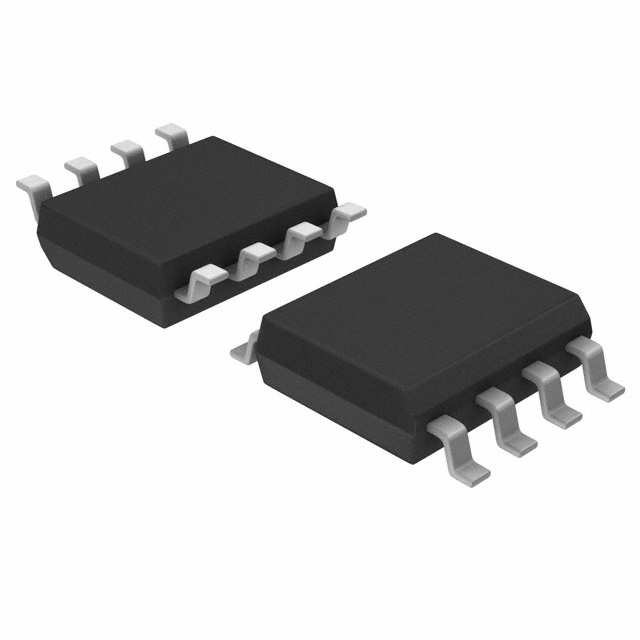Viz Specifikace pro podrobnosti o produktu.

MSP430G2230ID
Product Overview
Category
The MSP430G2230ID belongs to the category of microcontrollers.
Use
It is commonly used in various electronic applications that require a low-power microcontroller.
Characteristics
- Low power consumption
- High performance
- Small form factor
- Integrated peripherals
Package
The MSP430G2230ID comes in a small outline integrated circuit (SOIC) package.
Essence
The essence of the MSP430G2230ID lies in its ability to provide efficient and low-power processing for embedded systems.
Packaging/Quantity
The MSP430G2230ID is typically sold in reels or tubes, with each reel or tube containing a specific quantity of microcontrollers.
Specifications
- Architecture: 16-bit RISC
- CPU Speed: Up to 16 MHz
- Flash Memory: 2 KB
- RAM: 128 bytes
- Operating Voltage Range: 1.8V to 3.6V
- Digital I/O Pins: 10
- Analog Inputs: 1
- Timers: 1x16-bit, 1x8-bit
- Communication Interfaces: SPI, I2C, UART
Detailed Pin Configuration
The MSP430G2230ID has a total of 20 pins, which are assigned for various functions such as power supply, input/output, communication, and programming. The detailed pin configuration is as follows:
- VCC - Power supply voltage
- GND - Ground
- P1.0 - General-purpose I/O pin
- P1.1 - General-purpose I/O pin
- P1.2 - General-purpose I/O pin
- P1.3 - General-purpose I/O pin
- P1.4 - General-purpose I/O pin
- P1.5 - General-purpose I/O pin
- P1.6 - General-purpose I/O pin
- P1.7 - General-purpose I/O pin
- RST - Reset pin
- TEST - Test mode pin
- XIN - Crystal oscillator input
- XOUT - Crystal oscillator output
- P2.0 - General-purpose I/O pin
- P2.1 - General-purpose I/O pin
- P2.2 - General-purpose I/O pin
- P2.3 - General-purpose I/O pin
- P2.4 - General-purpose I/O pin
- P2.5 - General-purpose I/O pin
Functional Features
The MSP430G2230ID offers several functional features that make it suitable for a wide range of applications:
- Low-power operation: The microcontroller is designed to consume minimal power, making it ideal for battery-powered devices.
- Integrated peripherals: It includes various integrated peripherals such as timers, communication interfaces, and analog inputs, allowing for versatile functionality.
- High performance: Despite its low power consumption, the MSP430G2230ID delivers high-performance processing capabilities.
Advantages and Disadvantages
Advantages
- Low power consumption extends battery life in portable devices.
- Integrated peripherals reduce the need for external components.
- Small form factor allows for compact designs.
- High-performance processing enables efficient execution of tasks.
Disadvantages
- Limited flash memory and RAM may restrict the complexity of applications.
- Limited number of digital I/O pins may limit the connectivity options.
Working Principles
The MSP430G2230ID operates based on a 16-bit reduced instruction set computing (RISC) architecture. It executes instructions stored in its flash memory, utilizing its integrated peripherals and registers to perform various tasks. The microcontroller can communicate with external devices through its communication interfaces, process analog signals using its analog inputs, and control timing using its timers.
Detailed Application Field Plans
The MSP430G2230ID finds applications in various fields, including but not limited to:
- Internet of Things (IoT) devices: The low-power consumption and integrated peripherals make it suitable for IoT applications that require efficient processing and connectivity.
- Wearable technology: Its small form factor and low power consumption make it ideal for wearable devices such as fitness trackers and smartwatches.
- Home automation: The microcontroller can be used to control and monitor various home automation systems, providing energy-efficient solutions.
- Industrial automation: Its high performance and integrated peripherals enable it to be used in industrial automation systems for control and monitoring purposes.
Detailed and Complete Alternative Models
- MSP430G2210ID: Similar to the MSP430G2230ID but with reduced flash memory and fewer I/O pins.
- MSP430G2253ID: Offers increased flash memory and additional I/O pins compared to the MSP430G2230ID.
- MSP430G2553ID: Provides higher performance and more advanced
Seznam 10 běžných otázek a odpovědí souvisejících s aplikací MSP430G2230ID v technických řešeních
Sure! Here are 10 common questions and answers related to the application of MSP430G2230ID in technical solutions:
Q: What is MSP430G2230ID? A: MSP430G2230ID is a microcontroller from Texas Instruments' MSP430 family, designed for low-power applications.
Q: What are the key features of MSP430G2230ID? A: Some key features include a 16-bit RISC architecture, 2KB flash memory, 128B RAM, multiple I/O pins, and low power consumption.
Q: What are some typical applications of MSP430G2230ID? A: MSP430G2230ID is commonly used in applications such as sensor nodes, battery-powered devices, home automation, and industrial control systems.
Q: How do I program MSP430G2230ID? A: MSP430G2230ID can be programmed using various development tools like Code Composer Studio (CCS) or Energia IDE, using C or assembly language.
Q: Can MSP430G2230ID communicate with other devices? A: Yes, MSP430G2230ID supports various communication protocols like UART, SPI, and I2C, allowing it to communicate with other devices such as sensors or actuators.
Q: How much power does MSP430G2230ID consume? A: MSP430G2230ID is known for its low power consumption, typically operating at less than 1mA in active mode and less than 1µA in standby mode.
Q: Can I use MSP430G2230ID in battery-powered applications? A: Yes, MSP430G2230ID's low power consumption makes it suitable for battery-powered applications where energy efficiency is crucial.
Q: What is the maximum clock speed of MSP430G2230ID? A: MSP430G2230ID can operate at a maximum clock speed of 16MHz, allowing for efficient execution of instructions.
Q: Can I expand the memory of MSP430G2230ID? A: No, MSP430G2230ID has fixed flash memory and RAM sizes, which cannot be expanded externally.
Q: Are there any development boards available for MSP430G2230ID? A: Yes, Texas Instruments offers various development boards like the MSP-EXP430G2 LaunchPad, which supports MSP430G2230ID and provides an easy-to-use platform for prototyping and development.
Please note that these answers are general and may vary depending on specific use cases and requirements.

